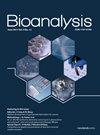Simultaneous quantitation of tigecycline, meropenem, polymyxin B in plasma, and protein-binding analysis in HSCT patients.
IF 1.8
4区 医学
Q3 BIOCHEMICAL RESEARCH METHODS
引用次数: 0
Abstract
Aims: To develop a UPLC-MS/MS method for quantifying tigecycline (TIG), meropenem (MER), polymyxin B1 (PB1), and PB2 in human plasma, and analyze their unbound fractions and influencing factors in HSCT patients.
Methods: Plasma samples from HSCT patients were analyzed using the developed UPLC-MS/MS technique.
Results: The method showed high accuracy, precision, and stability. Protein binding rates were 82.4% for TIG, 83.7%-79.3% for PB1, and 86.7%-82.6% for PB2, with lower binding at trough vs. peak concentrations.
Conclusions: Preliminary analysis suggests that BMI and serum albumin may influence PB1/PB2 binding in CRE-infected HSCT patients though larger cohorts are needed for confirmation. (clinical trial registration # 2021-0938-01).
造血干细胞移植患者血浆中替加环素、美罗培南、多粘菌素B的同时定量和蛋白结合分析。
目的:建立UPLC-MS/MS定量人血浆中替加环素(TIG)、美罗培南(MER)、多粘菌素B1 (PB1)和PB2的方法,并分析其未结合组分及其影响因素。方法:采用开发的UPLC-MS/MS技术对HSCT患者的血浆样本进行分析。结果:该方法准确度、精密度高,稳定性好。TIG的蛋白结合率为82.4%,PB1为83.7% ~ 79.3%,PB2为86.7% ~ 82.6%,波谷浓度与波峰浓度的结合率较低。结论:初步分析表明,BMI和血清白蛋白可能影响cre感染的HSCT患者的PB1/PB2结合,但需要更大的队列来证实。(临床试验注册号2021-0938-01)。
本文章由计算机程序翻译,如有差异,请以英文原文为准。
求助全文
约1分钟内获得全文
求助全文
来源期刊

Bioanalysis
BIOCHEMICAL RESEARCH METHODS-CHEMISTRY, ANALYTICAL
CiteScore
3.30
自引率
16.70%
发文量
88
审稿时长
2 months
期刊介绍:
Reliable data obtained from selective, sensitive and reproducible analysis of xenobiotics and biotics in biological samples is a fundamental and crucial part of every successful drug development program. The same principles can also apply to many other areas of research such as forensic science, toxicology and sports doping testing.
The bioanalytical field incorporates sophisticated techniques linking sample preparation and advanced separations with MS and NMR detection systems, automation and robotics. Standards set by regulatory bodies regarding method development and validation increasingly define the boundaries between speed and quality.
Bioanalysis is a progressive discipline for which the future holds many exciting opportunities to further reduce sample volumes, analysis cost and environmental impact, as well as to improve sensitivity, specificity, accuracy, efficiency, assay throughput, data quality, data handling and processing.
The journal Bioanalysis focuses on the techniques and methods used for the detection or quantitative study of analytes in human or animal biological samples. Bioanalysis encourages the submission of articles describing forward-looking applications, including biosensors, microfluidics, miniaturized analytical devices, and new hyphenated and multi-dimensional techniques.
Bioanalysis delivers essential information in concise, at-a-glance article formats. Key advances in the field are reported and analyzed by international experts, providing an authoritative but accessible forum for the modern bioanalyst.
 求助内容:
求助内容: 应助结果提醒方式:
应助结果提醒方式:


